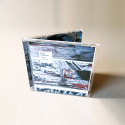Terra Subfonica. DANIEL BLINKHORN
(Gruenrekorder 2013)
Review by Jay-Dea Lopez
Sounds that exist beyond the periphery of our consciousness have a curious way of burrowing their way into our mind. They pulse below us, somewhere in the margins, yet they exert influence over our moods thoughts and desires. It has often been through the work of field recordists that we listen attentively to the marginalised sounds of the familiar for the first time. It is these sounds, from the subsonic terrain, that Daniel Blinkhorn observes in “Terra Subfonica”.
From domestic interiors to public exteriors to the body itself “Terra Subfonica” is comprised of 19 short tracks. Due to Blinkhorn’s broad focus the subject material is diverse yet his compositional style creates a sense of unity between each work. With each short piece Blinkhorn shows sensitivity towards the original object, this is especially evident in the way he allows the field recordings to clearly identify the sounding object. Unlike many acousmatic works the compositions found on “Terra Subfonica” do not intend to shroud the original source material, instead we hear objects such as alarms, computers, children’s toys and cityscapes in close proximity. Blinkhorn uses the microphone as his instrument. That which was at the periphery is now placed at the centre. Although this has become standard practise for many field recordists it is in Blinkhorn’s compositional style that “Terra Subfonica” finds its unique and deeply human voice.
“Sub Chron i” is the first of Blinkhorn’s compositions interpreting sounds from the domestic space. Here Blinkhorn records the sounds of inner clock mechanisms, chimes and pendulums, all of which serve to navigate our way through the periods of day and night. Through the use of layering and delays Blinkhorn creates a magical ambience. Listening to “Sub Chron i” the progression of time is no longer associated with the drudgery of routines or ageing, instead it is something to treasure, an element that unifies us all. Similarly “Toy bagatelle iii” explores the relationship between humans and sound. Here a single note from a toy piano is stretched and processed to reflect upon the connection between time and the imagination. And so it does …
From the periphery of public space comes “Relatively loud tones”. Layers of field recordings of alarms, church bells and warning signals are subtly juxtaposed with human voices. Tones fade in and out unobtrusively, processed again with the airy delays that characterise much of the work on “Terra Subfonica”. It is an interesting paradox that “Relatively loud tones” is one of the gentler compositions on the release. Blinkhorn’s intent is clearest here: even the loudest of signals can be marginalised by the human psycho-acoustic filter.
Finally, “Terra Subfonica” turns its attention to the sounds of the human body in works such as “corpus sanus – hominis” and “voix sous”. In “corpus sanus – hominis” recordings of the heart, blood, and lungs are made by taping a microphone to the body. External sounds from a street are layered alongside those of the body, providing an insight into the way in which the exterior affects the interior. Again Blinkhorn contextualises sound within the scope of the human condition. What could otherwise be a work of abstraction is instead characterised by a sense of humanity.
Blinkhorn recorded much of the work on “Terra Subfonica” whilst working as the artist-in-residence at the Australian Broadcasting Corporation in 2010. From Blinkhorn’s time as the ABC’s resident artist he has created a work of subtlety and sensitivity. After listening to “Terra Subfonica” we approach the world with renewed curiosity, we search for the sonic terrain that exists in the margins.
[Daniel Blinkhorn; photo courtesy of Ablaze records]




Leave a Reply